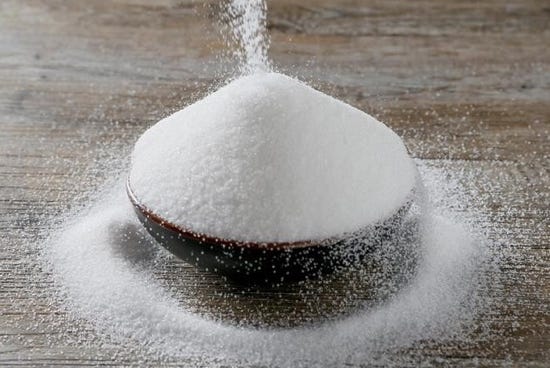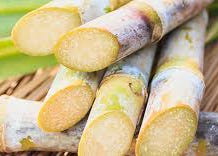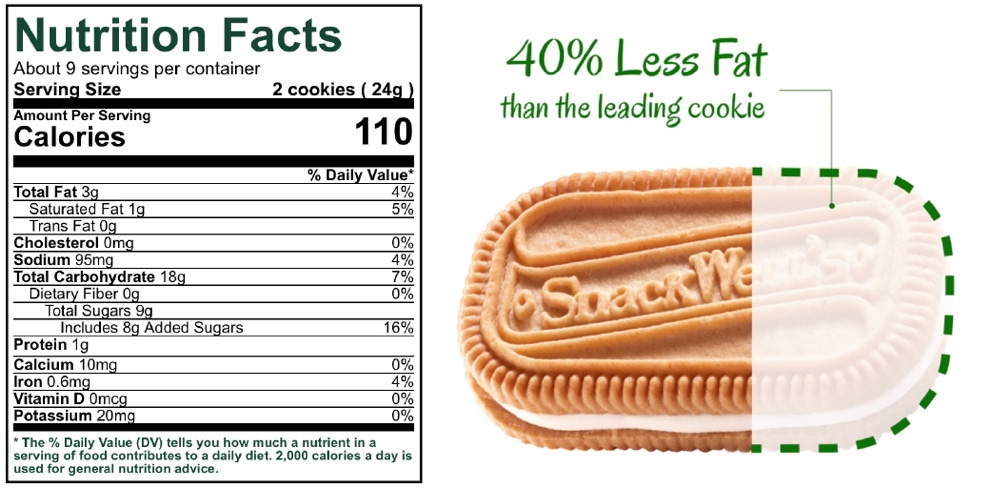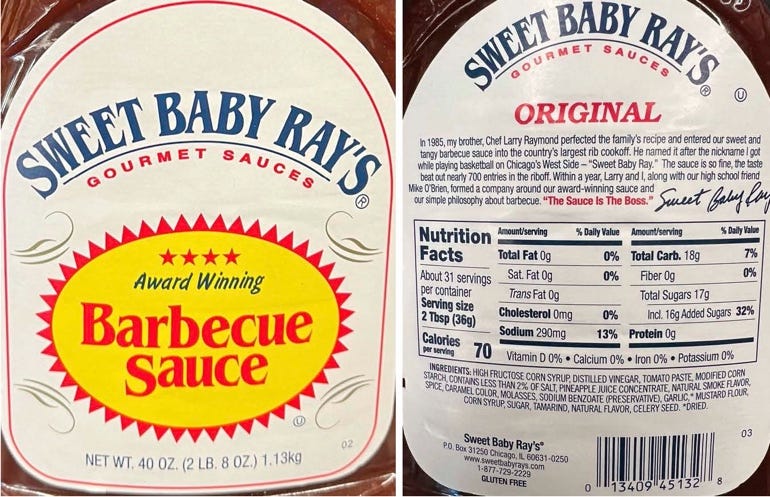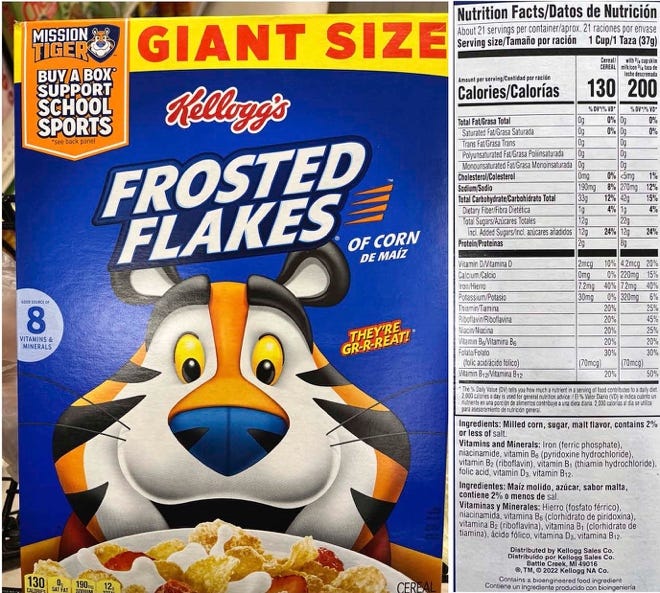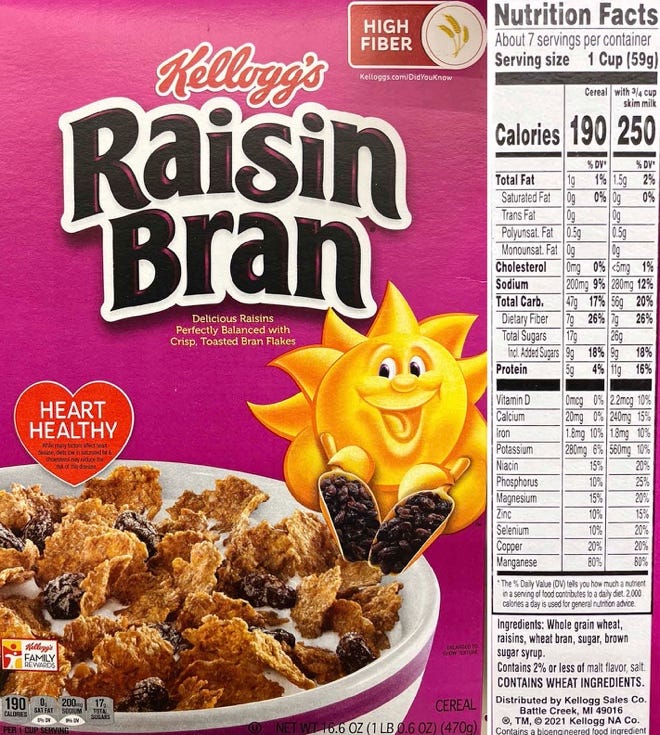Pure, White and Deadly
Cocaine has been described as “pure, white and deadly.” Some, a rising chorus, believe another pure, white substance is more addictive, more pernicious, and more deadly than cocaine … sugar. The effects of cocaine are readily apparent; the effects of sugar are more insidious; they can take a lifetime to be recognized.
Yes, there is a book entitled Pure, White and Deadly, and I did crib its title for this post.
We know what sugar is … it’s the white stuff that goes into our coffee or tea; it’s the brown stuff that goes on our oatmeal … it’s the stuff that makes everything sweet or sweeter. There’s even more “stuff” more onerous … we’ll get to that other “stuff” shortly …
Now we have to get a little biochemical. The term “sugar” describes a group of molecules consisting of carbon, hydrogen and oxygen atoms. It is a carbohydrate; you can readily identify members of this group because all of their names end in “-ose;” sucrose, lactose, glucose, dextrose, fructose, galactose. All of these molecules dissolve in water and, to varying degrees, taste sweet to us.
The most common use of the generic word “sugar” refers to sucrose, the white crystals that go into our coffee. Sucrose is composed of equal parts of glucose and fructose; it is the fructose that makes sucrose particularly sweet. It’s also fructose that is the most pernicious. Fructose is found naturally in fruits and honey.
Now a little physiology. When you eat and your food is digested, your body manufactures glucose that circulates in your bloodstream. This “blood sugar” is your body’s main source of energy. Insulin, a hormone manufactured in your pancreas, moves the circulating blood glucose into your cells. Most of the cells in your body use glucose along with fats and amino acids, the building blocks of protein, for energy. After body uses as much glucose as it needs for the then current energy demands, any leftover glucose is stored to be used later if needed.
It's the “stored to be used later” that is the problem today. The United States as well as the rest of the world is experiencing an obesity epidemic.
The prevalence of obesity in the United States increased from 30.5 percent of the population in 1999-2000 to 41.9 percent over the period 2017-March 2020, well over one-third of the US population racing towards one-half. During the same period, the prevalence of severe obesity increased from 4.7 percent to 9.2 percent, almost 1 in every 10 persons.
The estimated annual medical cost of obesity in the United States was nearly $173 billion in 2019 dollars. Medical costs for adults who had obesity were $1,861 higher than medical costs for people with healthy weight.
Childhood obesity is likewise a serious problem. For children and adolescents aged 2-19 years in 2017-2020 the prevalence of obesity was 19.7 percent and affected about 14.7 million children and adolescents; that’s 1 child in every 5.
Stierman, B., et al., “National Health and Nutrition Examination Survey 2017–March 2020 Prepandemic Data Files Development of Files and Prevalence Estimates for Selected Health Outcomes,” National Health Statistics Reports, NHSR No. 158 (June 14, 2021). http://dx.doi.org/10.15620/cdc:106273
Worldwide the picture is just as grim. In 2016, 39 percent of adults aged 18 years and over were overweight. Overall, about 13 percent of the world’s adult population, 11 percent of men and 15 percent of women, were obese. The prevalence of overweight and obesity among children and adolescents aged 5-19 has risen dramatically from just 4 percent in 1975 to just over 18 percent in 2016. The worldwide prevalence of obesity nearly tripled between 1975 and 2016. https://www.who.int/news-room/fact-sheets/detail/obesity-and-overweight (2021)
How is “obesity” determined? The most common measure is body mass index (BMI), which is defined as the ratio of weight to height, calculated as weight (kg)/height (m2), or weight (lb)/height (in2) multiplied by 703. Normal weight is considered a BMI between 18.5 and 24.9; overweight is a BMI between 25.0 and 29.9; obesity is a BMI of 30.0 or higher. Severe obesity is a BMI of 40 or more. https://www.cdc.gov/obesity/basics/adult-defining.html
BMI is the most widely used measure by physicians, simply because it is the easiest. However, BMI does not distinguish between the four body elements of bone, muscle, subcutaneous fat, and visceral fat. “Visceral fat is a type of fat that lies deep within your abdominal walls and surrounds your organs. Some levels of visceral fat are healthy and help protect your organs. However, too much visceral fat can be dangerous for your health.” https://my.clevelandclinic.org/health/diseases/24147-visceral-fat
A reasonable proxy for visceral fat is belt size; greater than 40 inches for males and 35 inches for females is a likely indicator of visceral fat, which is correlated with insulin resistance and risk for metabolic disease in adults and children. E. Jacobs, et al., “Waist Circumference and All-Cause Mortality in a Large US Cohort,” Arch. Int. Med. 170(15):1293-301 (2010). https://doi.org/10.1001/archinternmed.2010.201. Some consider a waist-to-hip ratio a more accurate indicator of visceral fat; greater than 0.85 in women and 1.0 in men. The ratio is determined by dividing the waist circumference, measured at the level of your umbilicus, your belly button, by the hip circumference, measured at the level where your hips are widest. A waist-to-hip ratio of 0.8 or less suggests metabolic normalcy.
We can all agree we have a problem with obesity. What’s sugar got to do with the problem?
We are programmed for sweetness. For prehistoric man sweetness was a signal that food was safe to eat. Most toxins, for example, alkaloids, have a bitter taste; a warning to a would-be eater. I. Shaw, Food Safety: The Science of Keeping Food Safe, 2nd Ed. (John Wiley & Sons, 2018). Hence, we naturally gravitate towards sweetness by default; “it’s in our genes.”
For eons the only sweet foods were ripe fruit and berries in season and honey, assuming you could get by the stinger-armed protectors of the bounty. (You might want to check with the local bear population about their experiences with the guardians.)
Sugar first entered our diets most probably by accident around 8,000 BC; the indigenous people of New Guinea chewed the cane stalk to extract its juice. It is believed that sugarcane was primarily a “fodder crop” to fatten pigs. N. Deerr, The History of Sugar: Volume One (Chapman and Hall, Ltd., 1949):15.
The sugarcane plant was domesticated in Southeast Asia and tropical India about 6,000 BC. When in 510 BC the Emperor Darius of what was then Persia invaded India he was astounded by the “reed which gives honey without the need for bees.” The manufacture of cane sugar granules from sugarcane juice was invented in India a little over two thousand years ago. Throughout Antiquity and the Middle Ages, sugar was a rare and expensive commodity, and considered a spice along with spices such as saffron and nutmeg. The first record of sugar in English is in the late 13th century. https://www.alimentarium.org/en/fact-sheet/history-sugar; https://en.wikipedia.org/wiki/History_of_sugar
Sugar was a luxury in Europe until the early 19th century. In 1747 German Andreas Sigismund Marggraf, a chemist, discovered sugar in beets and devised a method to extract it. Now not constrained to cane, commercial production of sugar from beets made it more widely available in Europe. Increased demand for sugar was largely a result of changes in European eating habits; more pastries, more processed food. (Sound familiar?)
European Food Information Council (EUFIC), “The Origins of Sugar from Beet,” (2001, revised 2020). https://www.eufic.org/en/food-production/article/sugar-how-is-it-produced-from-beet-infographic
There is a lot more history associated with sugar; extensive planting of sugar cane in the Caribbean, sugar trade embargoes, sugar as a factor in slave trade, international politics, and much more. You can find lots of books about sugar as a commodity, as well as online.
To understand the impact of sugar on the American diet, and specifically the rampant obesity, we have to take a detour into the decades of raging debate about the causes of heart disease. The foundational observations in the 1950s were the seeming heart-disease epidemic and changes in the American diet. The “epidemic” was blamed on an increase in meat and fat in the American diet … “fat is bad” … “eat fat, get fat.” The announced “solution” was a “low-fat, low-cholesterol” diet, adopted and promoted by the US Government and all of the “name” proponent organizations, the American Heart Association, the American Diabetic Association, the American Medical Association. What ensued was a multi-decade dietary experiment foisted on the American population that continues today with world-wide reach.
That the low-fat, low-cholesterol recommendations were based on false assumptions, shoddy scientific research, and proponent egos has only been exposed in fairly recent times; basically after sixty plus years of flat-out wrong dietary recommendations from the US Department of Agriculture (the food pyramid and now the plate), medical doctors, and biased researchers. Don’t eat meat, eggs or dairy because of their saturated fats; use vegetable oils instead of butter; eat more carbohydrates, specifically grains.
Once the “fat is bad” mantra was fully promulgated, the industrial producers introduced thousands of food products touting their low-fat, low-cholesterol attributes, virtually all of which were and are manufactured using unsaturated trans-fats, trans-fatty acids, vegetable oil to which hydrogen is added converting the liquid into solid fat at room temperature (for example, Crisco, which was introduced in 1911 by Procter and Gamble). Eating trans-fat raises the level of LDL (“bad”) cholesterol in the blood. Based on continuing research on partially-hydrogenated oils (PHOs), the US Food and Drug Administration (FDA) in 2015 finally determined them to not be Generally Recognized as Safe (GRAS), but gave manufacturers until January 1, 2020, to remove them from food products. Any ingredient listed as GRAS may be used in foods without testing by the Government, and without the manufacturer having to report such use. Needless to say, the food industry fought the abolition of trans-fats at every step; they are cheap. It was only research that could not be attacked away and political pressure from consumer advocates and the public that forced the FDA to act. How many decades have we all been eating trans-fats and paying the consequences today … about seventy years.
Low-fat food has no taste. A friend described low-fat as “eating day-old cardboard.” So, how to not only make low-fat foods edible, but also to get people to buy them. The obvious answer (you know what’s coming …) is add sugar, lots and lots of sugar, the more the better. “Out of 600,000 food items in a grocery store, 80 percent contain added sugar …” https://www.medicaldaily.com/opinion-nutrition-facts-labels-may-soon-include-added-sugar-info-food-companies-308834
But cane sugar, because of the subsidies and tariffs, was very expensive. There needed to be a better, read cheaper, alternative. Chemistry to the rescue. In 1966 Yoshiyuki Takasaki, a Japanese scientist, invented high fructose corn syrup (HFCS), corn having the same sweetness as sugar but costing about half as much. By the mid-1970s HFCS found its way into nearly every food product produced in the US. Currently, 6 percent of the US corn crop is turned into HFCS.
Sidebar: “Today’s corn crop is mainly used for biofuels (roughly 40 percent of U.S. corn is used for ethanol) and as animal feed (roughly 36 percent of U.S. corn, plus distillers grains left over from ethanol production, is fed to cattle, pigs and chickens). … Only a tiny fraction of the national corn crop is directly used for food for Americans, much of that for high-fructose corn syrup.” J. Foley, “It’s Time to Rethink America’s Corn System,” Scientific American (March 5, 2013).
The worldwide single largest user of sugar in all of its forms is Coca-Cola. Although Coke still uses cane and beet sugar outside the US, within the US virtually all of its “sugar” sweeteners are HFCS.
U.S. Department of Agriculture, Economic Research Service, “Sugar and Sweeteners: Background, “ (2021). https://www.ers.usda.gov/topics/crops/sugar-and-sweeteners/background/; J. Yudkin, “Pure, White, and Deadly,” (Penguin Books, 1972, 1986) 202; https://www.motherjones.com/food/2019/07/the-secret-history-of-why-soda-companies-switched-from-sugar-to-high-fructose-corn-syrup/
“The increase in fructose intake is worrisome … because it suspiciously parallels increases in obesity, diabetes, and a new condition called nonalcoholic fatty liver disease that now affects up to one-third of Americans. … Virtually every cell in the body can use glucose for energy. In contrast, only liver cells break down fructose. … One of the end products is triglyceride, a form of fat. Uric acid and free radicals are also formed.
None of this is good. Triglycerides can build up in liver cells and damage liver function. Triglycerides released into the bloodstream can contribute to the growth of fat-filled plaque inside artery walls. Free radicals (also called reactive oxygen species) can damage cell structures, enzymes, and even genes. Uric acid can turn off production of nitric oxide, a substance that helps protect artery walls from damage. Another effect of high fructose intake is insulin resistance, a precursor to diabetes.
In the 1970s and 1980s, the "fat is bad" mantra prompted a big shift in the American diet. People and food companies replaced fat, often healthy fat, with sugar, almost always refined sugar. But this sort of low-fat diet—one rich in refined sugar and thus in fructose—is really a high-fat diet when you look at what the liver does to fructose …
P. Skerrett, “Is fructose bad for you?,” Harvard Health (April 26, 2011).
https://www.health.harvard.edu/blog/is-fructose-bad-for-you-200705012507
Naturally occurring fructose in whole fruits does not have the same effect on your body because the fruits also contain fiber which mitigates the harmful effects of the fructose. Eat the orange, don’t just drink the juice. In the juice you only get the fructose, not the fiber.
Remember Nabisco SnackWell’s, the no-guilt cookie … low in fat so you can keep eating them. Look at the SnackWell’s nutrition label: serving size is two cookies, 24 grams, added sugars 8 grams, one-third of the cookies is sugar, brown sugar and molasses, fortunately no HFCS.
Food is sustenance. There are only two things more important than food: air and water. You can survive without food for a considerable time; not true of air and water. But food is also more than sustenance, it is also pleasure. Unfortunately, today what we typically think of as “food” has been reformulated into a toxic addictive substance.
Human physiology evolved on a diet containing very little no sugar and virtually no refined carbohydrate. There is no physiological function of your body that requires added sugar, none, not one single function, aucun, keiner, nada, zip, zilch. J. Yudkin, “Evolutionary and Historical Changes in Dietary Carbohydrates,” Am. J. Clin. Nutrit., 20(2):108–115 (February 1967). https://doi.org/10.1093/ajcn/20.2.108
According to the vast majority of people, French fries can only be consumed with ketchup (ok, there are some people that demand vinegar with their Fish and Chips). I am a strict adherent to that proposition, and Heinz is absolutely the best. Heinz even grows a special tomato cultured solely for its ketchup. However, take a look at the label on the Heinz Ketchup bottle. Serving size is 1 tablespoon, 17 grams. Total sugars equal 4 grams; added sugars equal 4 grams; just under one-quarter of each serving is sugar. How many tablespoons do you actually use? Bet it’s not just one …
The other day I ate some potatoes to which I added Heinz Ketchup. I was surprised and stunned at the sweetness of the ketchup, a major sugar load. I barely tasted the potatoes. Obviously, I had been sensitized to the sweetness by earlier writing the above.
Swamping everything with sugar hides flavors and blunts sensitivity of palate. J. Yudkin, “Pure, White, and Deadly,” (Penguin Books, 1972, 1986) 183-184.
How about Sweet Baby Ray’s Barbeque Sauce. Serving size is 2 tablespoons, 36 grams. Total sugars are 17 grams, of which 16 grams are added sugars. Do the math, half a serving of Sweet Baby Ray’s Barbeque Sauce is sugar. What kind of sugar? The lead off ingredient is “high fructose corn syrup;” next is “pineapple juice concentrate,” more sugar; then “molasses,” another form of sugar; “corn syrup,” the feedstock for HFCS; and finally just plain “sugar.” We should not overlook “natural flavor,” most of which is processed from GMO Field Corn No. 2. Think about this when you coat the chicken on the grill with Sweet Baby Ray’s Barbeque Sauce, how many tablespoons do you use?
How about what you feed your children? One-third of a serving of Kellogg’s Frosted Flakes is sugar, 12 grams out of 37 grams, all added sugar. Poor old regular Kellogg’s Corn Flakes is a mere ten percent sugar, 4 grams out of 42 grams.
A 59-gram serving of Kellogg’s Raison Bran, often considered an adult cereal, contains a total of 17 grams of sugar of which 9 grams is added. About 30 percent of a serving of Raison Bran is sugar, half of which has been added.
I’m not just picking on Kellogg’s; Post, General Mills, Quaker and other cereal manufacturers are basically the same.
“It’s clear that sugar and processed food drive obesity, heart disease, stroke, diabetes, and fatty liver disease, and there’s emerging data that processed food is responsible for cancer and dementia as well.” R. Lustig, Metabolical (Yellow Kite, 2021), p. 62.
“Diet advice that recommends we eat whole foods and avoid processed foods (foodlike substances) removes virtually all refined sugars by definition; diet advice to avoid sugar means, by definition, that we avoid virtually all processed foods.” Gary Taubes, The Case Against Sugar (Portobello Books, 2017), p. 280.
Even when we try to be vigilant, we can get tripped up.
Look at the “Nutrition Facts” and the “Ingredients” label on the Chobani Zero Sugar yogurt. At the very beginning here I pointed out that any word that ends in “-ose” is sugar. The ingredients here include “allulose.” “Allulose is a rare sugar that naturally occurs in fruits like figs and raisins.” https://www.webmd.com/diet/features/what-is-alluose The operative word here is “sugar.” Allulose is considered GRAS by the FDA, recommended by some, but more research is needed. H. Daniel, Hauner H., Hornef M., and Clavel T., “Allulose in human diet: the knowns and the unknowns,” Br J Nutr. 128(2):172-178 (2022). https://doi.org/10.1017/S0007114521003172 Nonetheless, there is sugar in a product that claims “zero sugar.”
We all like sweet food; we have been programmed by our evolution. But how much of this “substance,” the bad stuff, is in your diet? Are you concerned? If so, what are you going to do about it? A simple test, how much time do you spend shopping in the center aisles of the grocery store, the “sugar aisles,” versus shopping on the edges of the store where largely unadulterated food is found?




